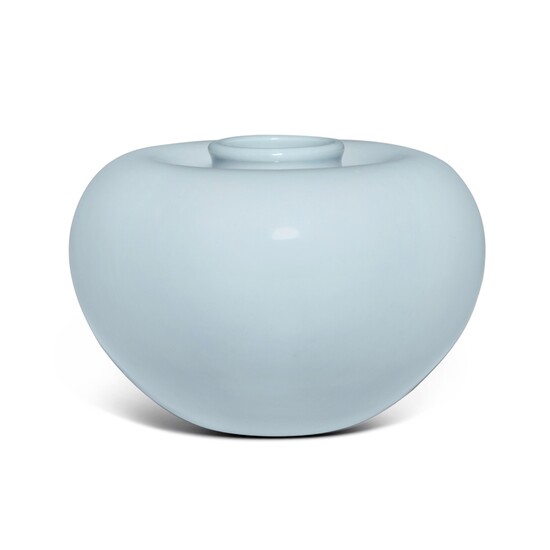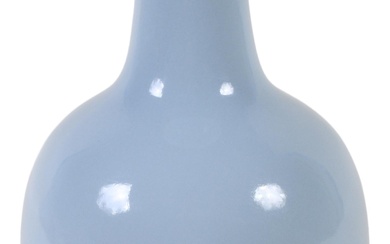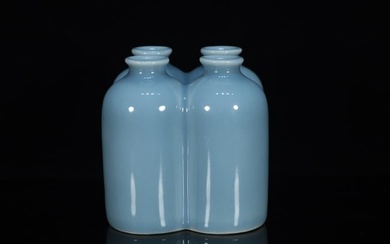A fine and rare clair-de-lune-glazed apple-shaped jar, Mark and period of Kangxi | 清康熙 天藍釉蘋果尊 《大清康熙年製》款
A fine and rare clair-de-lune-glazed apple-shaped jar
Mark and period of Kangxi
清康熙 天藍釉蘋果尊 《大清康熙年製》款
the base with a six-character mark in underglaze blue
Diameter 4⅛ in., 10.5 cm
Condition Report:
In overall excellent condition with minute firing imperfections, including a short firing flaw to the base (above the 'nian' and 'kang' characters, also visible to the interior), and a minor burst air bubble and short body line to the mouth rim.
整體品相良好,見少許微細窰燒瑕疵,其包括底部一微細短道縮釉(見於年、康字上方,內底亦見),口沿見一微小爆釉及一微細短道胎線。
For more information on and additional videos for this lot, please contact serina.wei@sothebys.com
Catalogue Note:
Elegantly potted, the present jar is remarkable for its perfection in form with its generous, rounded sides rising from a concave base to a narrow waisted neck, recessed into the shoulder to form a deep channel around the rim. Equally remarkable is the luminous clair-de-lune glaze that envelops the jar, complementing the rounded form to achieve a balanced harmony. This high-fired lavender-blue glaze, with a cobalt content of about 1%, was first produced by the imperial kilns in Jingdezhen during the Kangxi Emperor's reign (1662-1722). Fittingly termed clair-de-lune ('moon light') in the West by 19th-century French connoisseurs, and as tianlan ('sky blue') in China, it was one of the most ingenious monochrome glazes created in Jingdezhen during the Kangxi reign, reserved exclusively for imperial porcelains. The color remained popular throughout the Qing dynasty, yet the soft and delicate hue of the Kangxi period was never again achieved in later wares.
Harmonious and sophisticated, the jar epitomizes the Kangxi Emperor's pursuit of quality and technical excellence at the kilns in Jingdezhen. Moreover, the monochrome glaze and its simplicity can also be seen as a nod to ceramics of the Song dynasty, which were praised for their restrained aesthetic refinement.
Vessels of this form in clair-de-lune glaze are rare. See six closely related examples from the George Dunton Widener Collection, assembled in the 19th and early 20th century, four preserved in the National Gallery of Art, Washington, D.C. (accession nos 1942.9.481, 1942.9.482, 1942.9.490 and 1942.9.491), and published in Virginia Bower et al., The Collections of the National Gallery of Art. Systematic Catalogue: Decorative Arts, Part II: Persian and Indian Rugs and Carpets, Washington, D.C., 1998, pp 93-5, the other two sold at Christie's New York, 16th September 2011, lots 1581 and 1589. Compare one included in the Min Chiu Society exhibition, Monochrome Ceramics of Ming and Ch'ing Dynasties, Hong Kong Museum of Art, Hong Kong, 1977, cat. no. 50; another in the Shanghai Museum, Shanghai, illustrated in Zhongguo taoci quanji / The Complete Works of Chinese Ceramics, Qing, vol. 1, Shanghai, 1999, pl. 114; one in the Metropolitan Museum of Art, New York (accession no. 1966.66.206.4), illustrated in Suzanne G. Valenstein, A Handbook of Chinese Ceramics, New York, 1989, pl. 240; one in the Baur Collection, Geneva, in John Ayers, The Baur Collection, Geneva: Chinese Ceramics, vol. III, Geneva, 1972, pl. A.319; and lastly one previously in the Meiyintang Collection, exhibited in Evolution to Perfection, Monte Carlo, 1996, cat. no. 147 and illustrated in Regina Krahl, Chinese Ceramics from the Meiyintang Collection, vol. 4 (II), London, 1994, pl. 1786, and sold in our Hong Kong rooms, 7th April 2013, lot 1.
本蘋果尊造形優美,器身圓潤外鼓,腹下緩緩斂束,底部內凹,短頸沿肩凹陷。通體施天藍釉,瑩潤淡雅,器形柔和豐滿,宛若天成。高溫天藍釉含鈷量僅為百分之一左右,於康熙年間在景德鎮官窰創燒。十九世紀法國鑑藏家稱之為「clair-de-lune」,意指「月光」。觀乎肇啟於康熙一朝的景德鎮單色釉品,天藍釉色一般只見於御瓷。終清一代,天藍釉器一直備受垂青,然而婉約素淨的色澤卻在康熙後不再復見。
此尊形體雅逸流暢,造工精純,體現了康熙帝對景德鎮窰燒瓷品質的要求。單色釉簡約素淨,蘊含恬淡克制的美學內涵,一度盛行於宋,清帝慕古,使其得以復興。
天藍釉蘋果尊甚為罕見。參考六件喬治•鄧頓•威德納舊藏近例,購於十九至二十世紀初,其中四例藏於美國華盛頓國家美術館(藏品編號1942.9.481、1942.9.482、1942.9.490 及 1942.9.491),載於 Virginia Bower 等,《The Collections of the National Gallery of Art. Systematic Catalogue: Decorative Arts, Part II: Persian and Indian Rugs and Carpets》,華盛頓,1998年,頁93-5,另外兩例售於紐約佳士得,2011年9月16日,編號1581及1589。敏求精舍展覽《明清一色釉瓷》亦見一例,香港藝術館,香港,1977年,編號50。另可比對上海博物館藏品,載於《中國陶瓷全集:清(上)》,上海,1999年,圖版114。紐約大都會藝術博物館亦有藏例(藏品編號1966.66.206.4),載於 Suzanne G. Valenstein,《A Handbook of Chinese Ceramics》,紐約,1989年,圖版240。另見日內瓦鮑氏典藏之器,載於 John Ayers,《Chinese Ceramics in the Baur Collection》,卷2,日內瓦,1999年,圖版178。玫茵堂舊藏一例,曾展於《Evolution to Perfection》,蒙地卡羅,1996年,編號147,載於康蕊君,《玫茵堂中國陶瓷》,卷4 (II),倫敦,1994年,圖版1786,售於香港蘇富比2013年4月7日,編號1。
Provenance:
Christie's London, 8th June 1987, lot 280.
J.J. Lally & Co., New York, 1987.
倫敦佳士得1987年6月8日,編號280
藍理捷,紐約,1987年
View it on
Sale price
Estimate
Reserve
Time, Location
Auction House
A fine and rare clair-de-lune-glazed apple-shaped jar
Mark and period of Kangxi
清康熙 天藍釉蘋果尊 《大清康熙年製》款
the base with a six-character mark in underglaze blue
Diameter 4⅛ in., 10.5 cm
Condition Report:
In overall excellent condition with minute firing imperfections, including a short firing flaw to the base (above the 'nian' and 'kang' characters, also visible to the interior), and a minor burst air bubble and short body line to the mouth rim.
整體品相良好,見少許微細窰燒瑕疵,其包括底部一微細短道縮釉(見於年、康字上方,內底亦見),口沿見一微小爆釉及一微細短道胎線。
For more information on and additional videos for this lot, please contact serina.wei@sothebys.com
Catalogue Note:
Elegantly potted, the present jar is remarkable for its perfection in form with its generous, rounded sides rising from a concave base to a narrow waisted neck, recessed into the shoulder to form a deep channel around the rim. Equally remarkable is the luminous clair-de-lune glaze that envelops the jar, complementing the rounded form to achieve a balanced harmony. This high-fired lavender-blue glaze, with a cobalt content of about 1%, was first produced by the imperial kilns in Jingdezhen during the Kangxi Emperor's reign (1662-1722). Fittingly termed clair-de-lune ('moon light') in the West by 19th-century French connoisseurs, and as tianlan ('sky blue') in China, it was one of the most ingenious monochrome glazes created in Jingdezhen during the Kangxi reign, reserved exclusively for imperial porcelains. The color remained popular throughout the Qing dynasty, yet the soft and delicate hue of the Kangxi period was never again achieved in later wares.
Harmonious and sophisticated, the jar epitomizes the Kangxi Emperor's pursuit of quality and technical excellence at the kilns in Jingdezhen. Moreover, the monochrome glaze and its simplicity can also be seen as a nod to ceramics of the Song dynasty, which were praised for their restrained aesthetic refinement.
Vessels of this form in clair-de-lune glaze are rare. See six closely related examples from the George Dunton Widener Collection, assembled in the 19th and early 20th century, four preserved in the National Gallery of Art, Washington, D.C. (accession nos 1942.9.481, 1942.9.482, 1942.9.490 and 1942.9.491), and published in Virginia Bower et al., The Collections of the National Gallery of Art. Systematic Catalogue: Decorative Arts, Part II: Persian and Indian Rugs and Carpets, Washington, D.C., 1998, pp 93-5, the other two sold at Christie's New York, 16th September 2011, lots 1581 and 1589. Compare one included in the Min Chiu Society exhibition, Monochrome Ceramics of Ming and Ch'ing Dynasties, Hong Kong Museum of Art, Hong Kong, 1977, cat. no. 50; another in the Shanghai Museum, Shanghai, illustrated in Zhongguo taoci quanji / The Complete Works of Chinese Ceramics, Qing, vol. 1, Shanghai, 1999, pl. 114; one in the Metropolitan Museum of Art, New York (accession no. 1966.66.206.4), illustrated in Suzanne G. Valenstein, A Handbook of Chinese Ceramics, New York, 1989, pl. 240; one in the Baur Collection, Geneva, in John Ayers, The Baur Collection, Geneva: Chinese Ceramics, vol. III, Geneva, 1972, pl. A.319; and lastly one previously in the Meiyintang Collection, exhibited in Evolution to Perfection, Monte Carlo, 1996, cat. no. 147 and illustrated in Regina Krahl, Chinese Ceramics from the Meiyintang Collection, vol. 4 (II), London, 1994, pl. 1786, and sold in our Hong Kong rooms, 7th April 2013, lot 1.
本蘋果尊造形優美,器身圓潤外鼓,腹下緩緩斂束,底部內凹,短頸沿肩凹陷。通體施天藍釉,瑩潤淡雅,器形柔和豐滿,宛若天成。高溫天藍釉含鈷量僅為百分之一左右,於康熙年間在景德鎮官窰創燒。十九世紀法國鑑藏家稱之為「clair-de-lune」,意指「月光」。觀乎肇啟於康熙一朝的景德鎮單色釉品,天藍釉色一般只見於御瓷。終清一代,天藍釉器一直備受垂青,然而婉約素淨的色澤卻在康熙後不再復見。
此尊形體雅逸流暢,造工精純,體現了康熙帝對景德鎮窰燒瓷品質的要求。單色釉簡約素淨,蘊含恬淡克制的美學內涵,一度盛行於宋,清帝慕古,使其得以復興。
天藍釉蘋果尊甚為罕見。參考六件喬治•鄧頓•威德納舊藏近例,購於十九至二十世紀初,其中四例藏於美國華盛頓國家美術館(藏品編號1942.9.481、1942.9.482、1942.9.490 及 1942.9.491),載於 Virginia Bower 等,《The Collections of the National Gallery of Art. Systematic Catalogue: Decorative Arts, Part II: Persian and Indian Rugs and Carpets》,華盛頓,1998年,頁93-5,另外兩例售於紐約佳士得,2011年9月16日,編號1581及1589。敏求精舍展覽《明清一色釉瓷》亦見一例,香港藝術館,香港,1977年,編號50。另可比對上海博物館藏品,載於《中國陶瓷全集:清(上)》,上海,1999年,圖版114。紐約大都會藝術博物館亦有藏例(藏品編號1966.66.206.4),載於 Suzanne G. Valenstein,《A Handbook of Chinese Ceramics》,紐約,1989年,圖版240。另見日內瓦鮑氏典藏之器,載於 John Ayers,《Chinese Ceramics in the Baur Collection》,卷2,日內瓦,1999年,圖版178。玫茵堂舊藏一例,曾展於《Evolution to Perfection》,蒙地卡羅,1996年,編號147,載於康蕊君,《玫茵堂中國陶瓷》,卷4 (II),倫敦,1994年,圖版1786,售於香港蘇富比2013年4月7日,編號1。
Provenance:
Christie's London, 8th June 1987, lot 280.
J.J. Lally & Co., New York, 1987.
倫敦佳士得1987年6月8日,編號280
藍理捷,紐約,1987年






